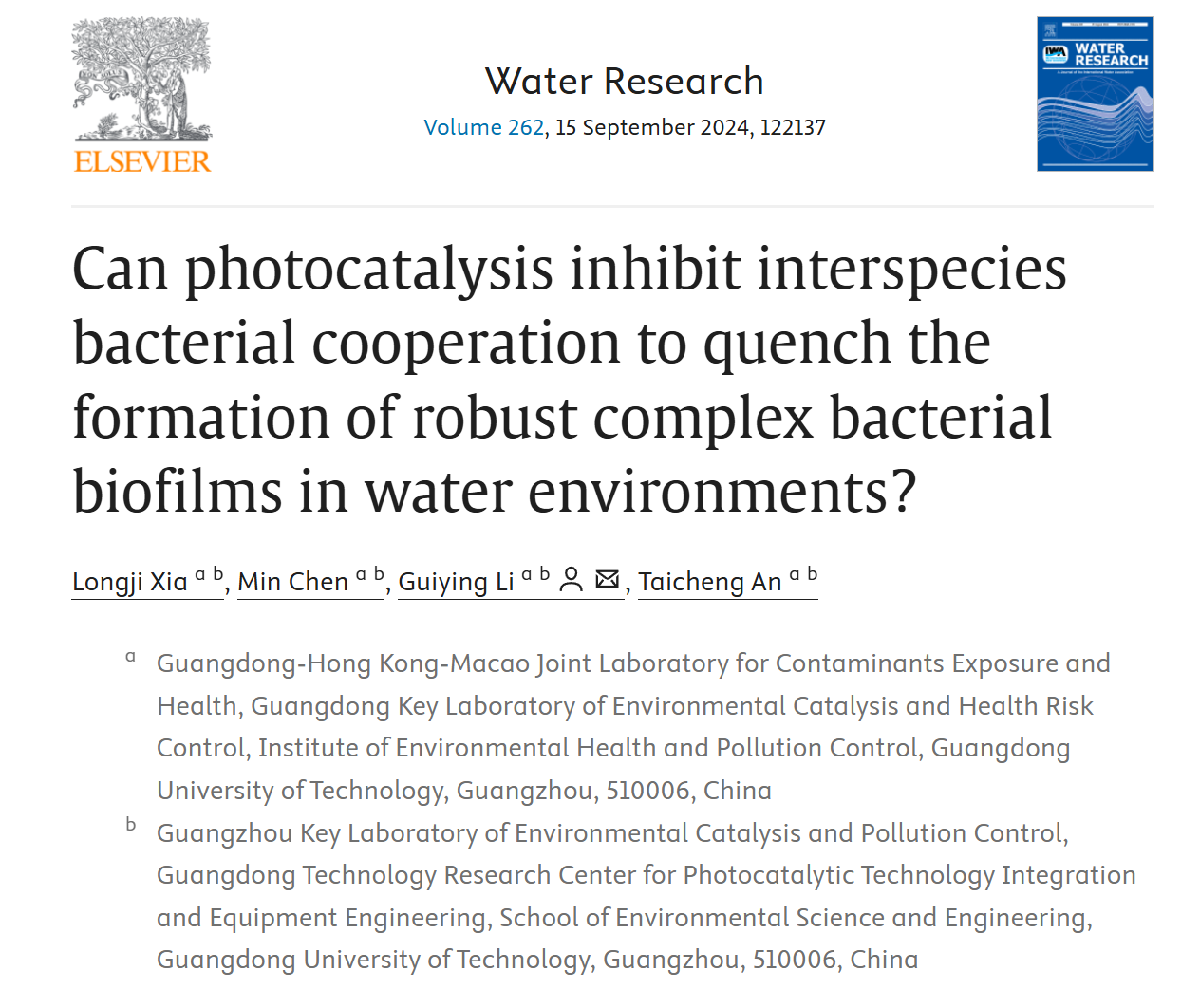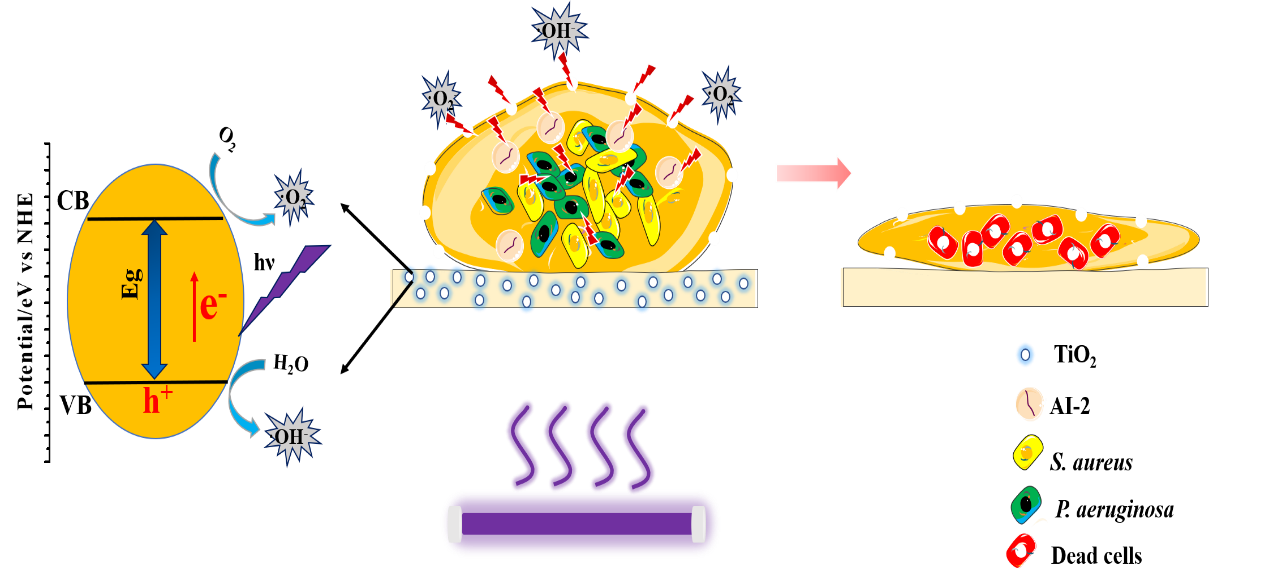近日,广东工业大学环境健康与污染控制研究院、环境科学与工程学院安太成教授团队题为《 Can photocatalysis inhibit interspecies bacterial cooperation to quench the formation of robust complex bacterial biofilms in water environments? 》的学术论文在 Water Research, 2024, 262: 12 2137 杂志上发表。论文的第一作者为 博士生夏隆基、第二作者为博士生陈敏,通讯作者为李桂英教授。 该研究主要关注水体中复杂混合生物膜在形成过程中的种间作用调节机制,并揭示了光催化胁迫下混合生物膜的种间作用调节及其抑制其生长的生物学机制。该研究可能为水环境中生物膜的形成和控制的提供一定的理论支撑。

论文DOI: https://doi.org/10.1016/j.watres.2024.122137
细菌生物膜作为条件性水生细菌病原体的环境蓄水池,对公众健康构成重大威胁。了解复杂细菌生物膜在不同刺激下的种间作用和应激反应调控机制是控制细菌生长和传播的关键。因此,本研究在流动式反应器中构建了金黄色葡萄球菌和铜绿假单胞菌两种菌株的混合生物膜,旨在揭示混合生物膜种间相互作用的调控机制,从而揭示光催化抑制生物膜的形成和生长机制。结果表明:与单种生物膜相比,混合生物膜具有更高的生长活性,可以更快形成交错的群落结构,菌群丰度更高。混合生物膜在不同生长阶段、不同环境下具有不同的种间作用,其种间相互作用受种间QS信号分子AI-2的调控。此外,与单一浮游菌群相比,混合生物膜对不同抗生素的耐药性显著提高(16 ~ 128倍),特别是对那些作用于蛋白质合成和细胞膜完整性的抗生素细菌的耐药性提高更多。在不同刺激胁迫的情况下,与单种生物膜相比,混合生物膜表现出更高的抗刺激能力。光催化能够在10 h内有效使混合生物膜生长抑制,比UVC照射下混合生物膜的抑制时间缩短了4倍。此外,光催化有效地去处混合生物膜的胞外聚合物,抑制了其种间群体感应信号分子autoinducer-2 (AI-2)的分泌。然而,AI-2诱导的相关毒力因子和生物膜生长相关基因的表达在TSM生物膜是光催化刺激前2 ~ 4 h内,最初上调3 ~ 10倍,随后显著下调。此外,AI-2前体4,5-二羟基2,3-戊二酮的加入有效延缓了TSM生物膜的光催化抑制效率。这些结果表明:光催化可以通过猝灭混合生物膜中的AI-2来抑制种间合作,从而有效地抑制生物膜的形成和生长。这项工作可可以为水环境中生物膜的形成和控制提供一定的技术支撑。
图片摘要:

ABSTRACT:
Bacterial biofilms pose significant a public health risk as an environmental reservoir for opportunistic aquatic bacterial pathogens. Understanding the interspecies roles of complex bacterial biofilms under different stimuli and regulatory mechanisms of stress responses is the key to controlling their dissemination. Herein, two-species mixture (TSM) biofilms (Staphylococcus aureus and Pseudomonas aeruginosa) were constructed in a flowthrough reactor. Compared with the single-species biofilms, the TSM biofilm had higher growth activity to reach maturity faster, forming a staggered community structure. Moreover, the TSM biofilm exhibited greatly improved resistance to different antibiotics (16−128 times higher), especially to those that act on protein synthesis and cell membrane integrity, when compared to single planktonic microorganisms. In the presence of stimuli, photocatalysis effectively inactivated the TSM biofilm within 10 h, a 4-fold shorter inactivation time compared to UVC irradiation. In addition, photocatalysis effectively depleted the extracellular polymers of the TSM biofilm and inhibited secretion of their interspecies quorum sensing signaling molecule autoinducer-2 (AI-2). However, the expression of AI-2 induced related virulence factors, and biofilm growth-related genes were initially up-regulated 3−10 fold for the TSM biofilm within the first 2−4 h of photocatalysis, followed by significant down-regulation. Furthermore, the addition of the AI-2 precursor 4,5-dihydroxy-2,3-pentanedione effectively delayed the photocatalytic inactivation efficiency of the TSM biofilm compared to the control. These results suggest that photocatalysis can effectively inactivate biofilms by inhibiting interspecies cooperation by quenching AI-2 in the TSM biofilm. This work sheds light on controlling biofilms in public health engineering systems.